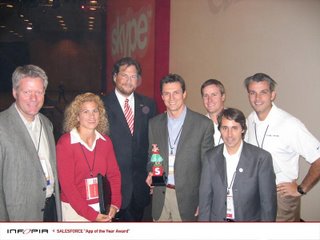The VC industry profits from secular disruptions. In IT, platform transitions – mainframe to client/server to web, etc – create massive disruptions, new companies, and fantastic returns to investors.
In a absolute sense, disruptive companies initially operate on the margin of major industries. GOOG, for example, is the leader in the online ad market, a market which represents less than 6% of the total advertising market.
It is often not the absolute levels of market share that drive market capitalization but rather the rate of relative change in new technology platform adoption. The rate of change is a function of the economics and value of the emerging technology platform.
GOOG’s market cap reflects the market consensus that the online market’s share of total advertising will grow from 6% to 10% to 20% and that GOOG will disproportionately benefit from the reallocation of spend.
Okay, online advertising is 6% of the total.
Anyone care to hazard a guess as to clean energy’s share of the US energy market?
Clean energy, a new vc darling, is 2.3% of the US electricity market.
The 2.3% breaks down the following way:
1.5% from bio-mass
0.44% from wind
0.36% for geothermal
0.01% for solar power.
The other 97.7%?
49.7% coal-fired
19.3% nuclear
19.1% natural gas
6.5% hydro
3% oil-fired
Wow. 97.7% is non-renewable, with 50% carbon spewing coal.
Now, the environmental benefits of clean energy aside, is clean energy economically competitive?
Caveat….the environmental impact/cost of traditional energy is not captured by market prices. Non-price costs are referred to as externalities and, ultimately, serve to understate the costs of traditional energy. Pricing externalities remains beyond the scope of the market – ie. What is the cost of Greenland’s melting ice sheets, who should pay for it, how should it be imputed into the market price for energy?
The DOE provides interesting answers as to price competitiveness. For a plant coming on-line in 2015, the per kilowatt hour prices, by energy source, are forecast to be:
Coal $0.0531 per kwh
Wind $0.0558 per kwh, or 1.051x coal
Natural Gas $0.0525 per kwh, or .98x coal
Nuclear $0.0593 per kwh, or 1.12x coal
Solar $0.30 per kwh, or 5.65x coal
Biomass $0.075 per kwh, or 1.41x coal
Geothermal $0.075 per kwh, or 1.41x coal
In essence, the DOE believes that, independent of subsidies, that only natural gas will be cheaper than coal. Importantly, wind, nuclear, biomass, and geo-thermal are approaching the cost of coal.
The sad fact is that in the absence of either 1) subsidies, 2) innovations in pricing models that can capture the costs of externalities, or 3) a material breakthrough in technology, that the importance of coal will be undiminished. This is reflected in TXU’s plan to build monster coal fired plants in TX – they are economic actors.
For the clean energy sector, the math does not yet work. In order for the 2.3% to become 5% then 10% then 20%, we appear to need two things
1) the analog of Black-Scholes pricing models to emerge. We need to develop a pricing model, that the market will accept, that can capture the externalities and hidden costs of non-renewable energy production.
2) A breakthrough not only in the cost of alternative energy production, but also an ability to scale. Wind today can serve 20m homes – we need massive increases in scale.
Monster companies emerge not when they own 20% of a market but when the market realizes that the economic advantages of the new platform will create massive dislocations in the market. When we see clean energy reach 5%, it will be interesting to see if a GOOG type company is leading the reallocation of capital with an economic value proposition that leaves coal, thankfully, in the dust…
See WSJ.com/reports for an excellent analysis of the topic above



